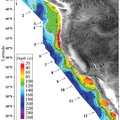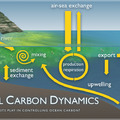Ocean acidification can account for approximately a quarter to half of the pH decrease in the deep waters of the Hood Canal relative to estimated pre-industrial values
Very little research has been done on how the impacts of ocean acidification may be manifested in estuaries and nearshore coastal areas and on how terrestrial and marine carbon cycles interact in estuarine and coastal environments. There is a strong need to assess the anthropogenic impacts of increases in atmospheric CO2, increases in runoff of nutrients and pollutants, and changes in freshwater and organic carbon inputs to estuarine and coastal systems. In addition to fundamentally altering important carbon flows in these ecosystems, natural and anthropogenic inputs from land may interact with ocean acidification and affect key benthic and pelagic organisms in coastal and estuarine systems, such as phytoplankton, sea grasses, calcareous crustose and macroalgae (e.g., kelp), molluscs (e.g., clams, oysters, scallops), crustaceans (e.g., krill, crabs, lobsters), and other invertebrates. Many of these organisms constitute or support commercially important fisheries and play central roles in the local ecology of these systems.
Although the West Coast does not have as many large rivers draining it as the East and Gulf coasts, a few large river-estuary systems on the West Coast may be particularly important in terms of terrestrial inputs to coastal and estuarine systems and their potential role in the development of corrosive conditions in coastal environments. In particular, Puget Sound already has significant anthropogenic impacts, including issues associated with invasive species, pollutants, and significantly altered freshwater, acid deposition, nutrient run-off, and sediment budgets as a result of the approximately five million people living in the watershed.
In 2008, the PMEL Carbon Program began to collaborate with scientists from the University of Washington and the Washington State Department of Ecology to conduct the first extensive high-quality carbon surveys in Puget Sound and found evidence suggesting that OA and other anthropogenic stressors are having synergistic negative impacts on this rich ecosystem. The research team estimated that ocean acidification accounts for approximately a quarter to half of the pH decrease in the deep waters of the Hood Canal sub-basin of Puget Sound relative to estimated pre-industrial (before 1800) values. The remaining change in pH between when seawater enters Puget Sound and when it reaches this deep basin results from the decomposition of organic matter. Over time, the relative impact of ocean acidification could increase significantly, accounting for 50–85 percent of the pH decrease in Puget Sound subsurface waters (depths greater than 40 meters) for a doubling of atmospheric carbon dioxide (Feely et al., 2010).
To better understand the effects of ocean acidification on shellfish within Puget Sound, the Puget Sound Partnership, with funds from the Environmental Protection Agency, has supported the Puget Sound Restoration Fund, UW, NOAA, Pacific Shellfish Institute, Washington Department of Ecology, Taylor Shellfish, and Baywater, Inc., to conduct collaborative studies investigating whether or not corrosive seawater is affecting shellfish populations. This work monitored both water conditions and shellfish larval settlement at two locations with important shellfish populations, Dabob Bay and Totten Inlet, during the growing seasons in 2009 and 2010. Final results from this work are not yet available. Much of the Puget Sound monitoring work is coordinated through the Northwest Association of Networked Ocean Observing Systems (NANOOS).
The PMEL Carbon Program has contributed to efforts in the Puget Sound basin by assisting with sampling surveys and equipping moorings with instruments that measure CO2 and ocean acidification. The CO2 measurements taken atop the Space Needle also complement our measurements in the marine environment in Puget Sound.
References
Feely, R.A., S.R. Alin, J. Newton, C.L. Sabine, M. Warner, C. Krembs, and C. Maloy, 2010. The combined effects of ocean acidification, mixing, and respiration on pH and carbonate saturation in an urbanized estuary. Estuarine, Coast, and Shelf Science, 88: 442-449.





